Penning down a list of top sporting performances isn’t as easy a task as it might seem on the surface. And if the game happens to be Cricket, the complexity simply compounds. With over 3,700 ODIs being played since its accidental inception in 1971, the genre has witnessed several legends. Records have been created and erased, and benchmarks have been elevated in the midst of an ever evolving game. And needless to say, every decade has had its share of breath-taking performance that has stayed in the minds of players and fans alike.Instances of bowler’s steamrolling batting lines up’s in dramatic fashion and batsmen dominating games will always be the favourites to make the cut. That said, those performances that were equally awe inspiring and stood the test of time were the ones that emerged in the face of adversity. When the shoulders drop and the morale takes a beating, an elite bunch of players emerge. And it’s this crop of cricketers that dish out performances to win games which were otherwise lost for all cause.In this compilation of great ODI performances, we recognise not just the record breaking events, but also those that fascinated an entire generation of fans. While there is a fair probability that your personal favourite isn’t on this list, we guarantee that the 10 identified here are ones that you will recognise as heroic acts of individual brilliance.
#10 Michael Bevan - 78* vs West Indies, January 1996
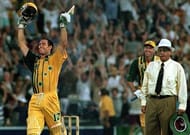
A successful run chase is as much about strategy and timing as it is about holding one’s nerve. And few did it better than Michael Bevan. Like an eagle scouting the horizon for prey, Bevan constantly watched the changing field-settings while trying to spot gaps. And often, with the hapless number 11 for company, he pulled many a rabbit out of the hat when guiding his side through seemingly hopeless situations.
One such scenario played out at the SCG in the Australian summer of 1996. Chasing 172, the hosts were tottering at 38/6 with Curtly Ambrose running a riot. Bevan’s first objective was to get close to the target. That was achieved in partnership with a brave Paul Rieffel who scored 34 vital runs. But with Rieffel departing and Shane Warne getting run out soon after, Glenn McGrath found himself on strike with 5 still required off 3 deliveries.
A single got Bevan back on strike – a fatal mistake from the West Indies. But the southpaw couldn’t score off the penultimate ball leaving him with four required of the final ball. As the over thirty-seven thousand strong crowd at the historic SCG held its breath, Bevan struck Roger Harper over the infield for four to seal another famous run-chase.
#9 Sachin Tendulkar 98 vs Pakistan, 2003 World Cup
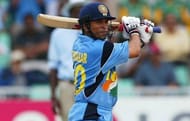
As expected, the build up to the India-Pakistan encounter at Centurion in the 2003 World Cup was enormous. India were unbeaten in the journey and more significantly, had overcome Pakistan in all their previous World Cup meetings. And as the two nations came to a stand-still, the anxiety surrounding the match was palpable.
When Saeed Anwar - a constant thorn in India’s flesh - scored a ton and Pakistan put 273 on the board, the capacity crowd in attendance and the millions watching on TV knew that the circumstances called for an out-of-the-ordinary effort. And when Sachin Tendulkar took strike ahead of Virender Sehwag, they probably guessed that they were in store from something special. They were so right!
Sachin’s three-punch combo of 6, 4, 4 to dent Shoaib Akhtar is now the stuff of folklore. If his six over square third-man brought the crowd to its feet, his flick off middle-stump and the customary straight drive evoked awe. And when he punched Wasim Akram off the back foot for four through the covers and held his pose with a high-elbow, all that Robin Jackman could manage on commentary was a “My goodness me”.
When a cramp-stricken Sachin eventually fell for 98 of 75 balls, the foundation was laid. Notwithstanding the successful run-chase, the game will always be remembered for the twelve boundaries and the now famous six had emanated from the “little master’s” willow.
#8 Viv Richards 138*, 1979 Word Cup Final
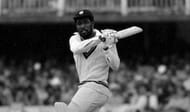
In the 1979 World Cup final, England won the toss and having elected to bowl, had the West Indies on the mat at 99/4. The defending champions were on the brink and their title was at stake. Viv Richards came in at the fall of the first wicket and he was joined by Collis King at the fall of the fourth.
Their partnership was to alter the course of the game. In perhaps one of the few instances if not the only such, Viv Richards was outscored in a partnership. Their collective essay yielded 139 runs and King had belted 86 of those in 66 balls.
Accustomed to receiving accolades, Richards on this occasion however, escorted King half way to the boundary when the later was dismissed. Such was the dominance of King that day. That said, Richards held the innings together. While King provided impetus to the innings, Richards was the rock. As the others played around him, the batting genius played a restrained yet dominant innings of 138 which was studded with 11 fours and 3 sixes.
His sheer presence in the middle through the course of the innings was a calming factor for the West Indies and had a debilitating effect on England. Michael Holding would later recall that such was Richards’s assured dominance that his six off the last ball of the innings to help post a formidable 286 quite simply deflated the English side. England subsequently were bowled out for 194 as the famed Caribbean side reigned supreme yet again.
#7 Gary Gilmour 6/14 vs England, 1975 World Cup semi-final
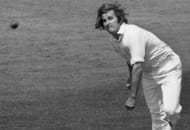
Fast bowling in the seventies was all about the West Indians. With brutal pace and bounce, they terrorised batsmen the world over. But in the semi-final of the 1975 World Cup, fast bowling of a different sort was on offer. Well before Wasim Akram delighted the world with his menacing art, Gary Gilmour’s left-arm swingers were a treat to watch.
Ambling in with his left arm swinging back and forth in a measured run-up, the Australian had the ability to move the ball both ways. If the Englishmen worried about Dennis Lillee, little did they know that Gilmour had something special up his sleeve for them that day at Headingley.
The pitch was green and damp and Ian Chappell didn’t have to ponder too much about sending England in to bat. Gilmour took charge from thereon. Swinging the ball viciously back in to the right handers, the southpaw produced a devastating opening spell of 6/10 to leave England reeling at 6/36. Not knowing which ones to play and which ones to leave, the hosts were all at sea against Gilmour’s prodigious swing bowling. England eventually folded for 93 after Max Walker and Dennis Lillee picked up the remaining wickets.
The run chase was mean to be a walk in the park. But the Aussies were in for a rude shock. With the conditions still conducive for new ball bowling, their top order was soon reeling at 6/39. With the batting stars back in the hut, Doug Walters was running out of partners. Enter Gary Gilmour – this time, with a bat in hand.
Playing the perfect ally for the composed Walters at the other end, Gilmour struck five boundaries en route to a run a ball 28. That was just what Australia needed as the partnership stemmed an embarrassing collapse. Needless to say, Gary Gilmour walked away with the man of the match honours for a truly incredible all-round show.
#6 Kapil Dev - 175 runs vs Zimbabwe, 1983 World Cup
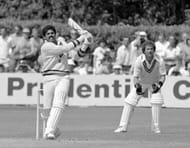
There’s a reason why the Indians love Kapil Dev. A rare blend of passion and courage, he was capable of pulling off inconceivable feats under dire circumstances. One of the few captains to inspire with his on-field actions, Kapil galvanised an entire nation with the World Cup win in 1983.
His innings of 175 will always be the benchmark for an act of innings-resurrection. Every time a team claws its way back from a hole, the inevitable comparison with Kapil’s innings is made. Also, the fact that there is no video footage or radio commentary only adds to the mystique of what is displayed in the score card from that day at Tunbridge Well.
For the record, Kapil won the toss and chose to bat. The decision backfired dramatically and he found himself at the crease with the score board reading 17/5. Peter Rawson and Kevin Curran had taken turns to dismantle the top order and India faced the rather embarrassing prospect of being whipped by Zimbabwe.
But Kapil had other ideas. He first stitched partnerships with Roger Binny and Madan Lal and later teamed up with Syed Kirmani. His ninth-wicket essay with the keeper was the most productive with 126 runs being scored in just sixteen overs. Kapil stayed unfased while the rest crumbled. As he shouldered the burden of responsibility, he stayed true to his instincts while plundering six 6s and 14 boundaries in a 138 ball innings. The skipper’s 175 made the difference on the night and the rest as they say is history, as a week later India were crowed world champions.
#5 Joel Garner 5/38 vs England, 1979 World Cup final
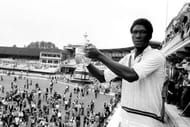
Having won the first ever World Cup, the West Indies were favourites to win the subsequent edition as well. Their bowling unit was formidable and boasted of a menacing pace-quartet in Andy Roberts, Joel Garner, Michael Holding and Colin Croft. But their fortunes fluctuated in the 1979 final.
At first, the West Indies were tottering at 99/4 but were catapulted to a formidable 286 by Collis Kings and Viv Richards. Then, England mounted a sedate but spirited response as Mike Brearley and Geoff Boycott stitched a 129 opening stand. With the asking rate climbing steadily, Clive Llyod knew that an English assault was coming and tossed the ball to Joel Garner in the 48th over for a second spell (Those were the days of 60 over ODIs).
Graham Gooch, who was looking good on 32, was the first to go – his stumps cleaned up by a Garner yorker. The elegant David Gower followed suit next, bowled for a duck. With Colin Croft dismissing Derek Randall, Ian Botham and Mike Hendrick at the other end, Garner accounted for Wayne Larkins, Chris Old and Bob Taylor (all for ducks).
Of the five wickets that Garner took that evening, four were by means of full pitched deliveries that struck timber. The match winning second spell from the 6ft 8in giant lasted just 11 balls but resulted in the hosts loosing 5 wickets for just four runs. England, at the receiving end of this astonishing outburst, collapsed from 183/2 to being bowled out for 194. Such was the ferocity of Garner that years later, Gordon Greenidge recalled that the spell was “great to watch but not nice to bat against.”
#4 Rohit Sharma 264 vs Sri Lanka, November 2014
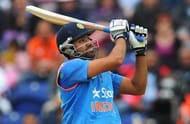
Rohit Sharma has for long been spoken of as one of the brightest talents to emerge from the Mumbai batsmen-factory. Rahul Dravid once spoke of watching a young Rohit in the nets and being wowed by the amount of time the youngster had to play a stroke. The Mumbaikar has come a long way since his early days of promise and is now paying rich dividends for the trust that was placed on his young shoulders.
A year after joining the elite 200-club, Rohit Sharma took strike against Sri Lanka at the fabulous Eden Garden in November 2014. It was the 150th anniversary of the Eden Gardens and little did the huge crowd in attendance know that they were in for a once in a lifetime event.
Dropped when on four by Thissara Perera, Sharma took time to get into his groove – even handing Angelo Mathews a maiden over. But after he got his eye in, he was unstoppable. With Sri Lanka not holding onto their catches (Ajantha Mendis dropped a tough return-catch with Sharma on 59), the gifted opener had the license to thrill.
His first 100 came at a run-a-ball and thereafter, he switched gears. His last 164 runs were scored of just 73 balls. 33 boundaries and 9 gravity-defying sixes later, the highest individual ODI score was achieved at the expense of Virender Sehwag’s personal best. Sharma was a freight train towards the end. His fifth wicket partnership with Robin Uthappa yielded 128 runs and such was the opener’s dominance that Uthappa scored a paltry 16 in the stand.
ODI Cricket had a new world record and Rohit Sharma showed that the hitherto impossible could be achieved more than just once. More importantly, he proved beyond doubt that he is one of the best ever to don the Indian blue and amongst the finest batsmen of his era.
#3 AB de Villiers 149 vs West Indies, January 2015
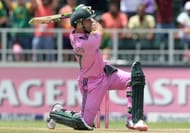
At 31 years of age, AB de Villiers has done enough and more for writers to pen down multiple best sellers. Supremely gifted and overflowing with all-round abilities, the South African skipper has turned demolition into an art form. His 149 on 18th January, 2015 was but another example of his super human abilities.
Rilee Rossouw had just been dismissed in the 39th over after playing his part in South Africa’s highest ever opening stand. The score board read 247/1 and out walked De Villiers. 16 balls later, Sanath Jayasuriya’s nineteen year record for the fastest ODI fifty was a thing of the past. The signs were ominous for the West Indies. Their young skipper, Jason Holder, summoned up the courage to take matters into his own hands. But all he could do was watch six of his nine deliveries to his counterpart fly into the stands.
There was not in shot in the book that De Villiers did not play that day. Soon enough, the record for the fastest ODI hundred fell. The batting wizard from Pretoria had achieved the milestone on his 31st ball. His second-wicket association with Hashim Amla yielded 192 runs from 67 deliveries with the latter contributing just 39.
When the delightfully brutal assault ended, De Villiers had carted an astonishing 16 hits over the fence – the most by a South African in an ODI innings. His strike-rate for the innings was a mind-numbing 338.63. The outcome of the game was a foregone conclusion and De Villiers had once again redefined the word “demolition” in the context of an ODI game.
#2 Shane Warne 4/29 vs South Africa, 1999 World Cup semi-final
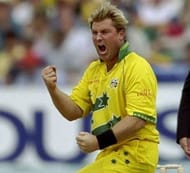
The stakes were high at Birmingham on the eve of the 1999 World Cup semi-final. Hansie Cronje was guiding his men into unchartered territory and the Australians were en route to doing what they do best – winning World Cups.
Riding on the brilliant Shaun Pollock (5/36) and Alan Donald (4/32), South Africa appeared confident. In restricting Australia to 213, the bowlers had done their job. And when Gary Kirsten and Herschelle Gibbs got to the twelfth over without any mishaps, the Proteas seemed on course. Glenn McGrath and Damien Fleming had failed to secure a breakthrough and the Aussies realised they had to strike sooner rather than later.
That was when Shane Warne stepped up to his bowling mark. His leg spinning beauty to get rid of Gibbs was just as good as his “ball of the century” that sent back Mike Gatting. And just like Gatting, Gibbs stood there wondering what had hit him. Five balls later, Gary Kirsten’s sweep-shot missed a drifting turner from the spin-wizard. As the ball struck the off-stump, the Aussies swarmed around Warne, who was now bellowing with cries of “c’mon c’mon.” Two balls later, as the crowd of nineteen thousand watched in anticipation, Hansie Cronje fell to a vicious turner that pitched well outside leg-stump and flew to Mark Waugh at first-slip.
From sitting pretty at 48/0, the Proteas were reduced to a nervous wreck at 53/3 – all in the course of two overs. While the Lance Klusener induced outcome to the game will be remembered forever, Shane Warne’s initial burst to alter the course of the game will always be a shining example of spirited spin bowling to rattle a top order in an ODI of enormous importance.
#1 Wasim Akram - 3/49 vs England, 1992 World Cup final
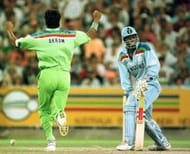
“Allan Lamb has been cleaned up! Perhaps so too England.”
It was a moment tailor made for Richie Benaud and his prediction was spot on. After a visibly shell-shocked Lamb departed, Chris Lewis walked in only to retrace his steps back to the hut having suffered the same fate. Two magical balls was all that it took for Wasim Akram to break England’s back.
At the start of the England innings, Akram had sent down a fearsome rising delivery that Ian Botham nicked. And after Mushtaq Ahmed had struck twice with his looping leggies, Akram took over again. Any ball leaving a right hander is always hard to play. But if it were to angle into towards middle stump and then change trajectory towards the off stick while moving at over 140 clicks, there’s very little that a batsman can do. And if Chris Lewis thought that bowling two magical deliveries on the trot was a near impossible feat, he was grossly mistaken. The one that he played on seemed to be levitating in air while moving a mile to do the damage that it intended to.
While these two magical deliveries are played over and over again on television every time Wasim Akram is talked about, not very many recollect that he played a vital role with the bat in that final as well. It was his 33 of 18 balls, studded with four boundaries that propelled Pakistan to a competitive 249 in the first place. It was an all-round display that lit up the final and one that deservingly attracted the man of the match award.
Brand-new app in a brand-new avatar! Download CricRocket for fast cricket scores, rocket flicks, super notifications and much more! 🚀☄️
